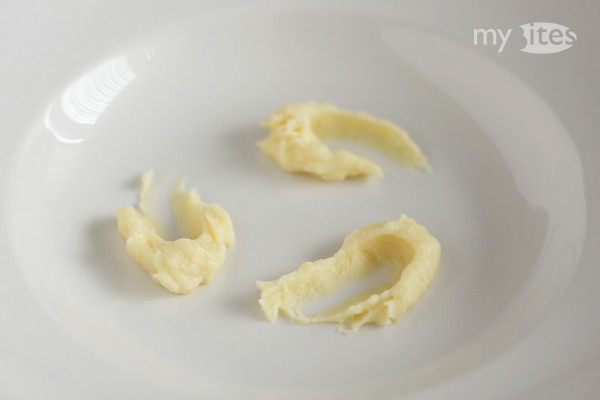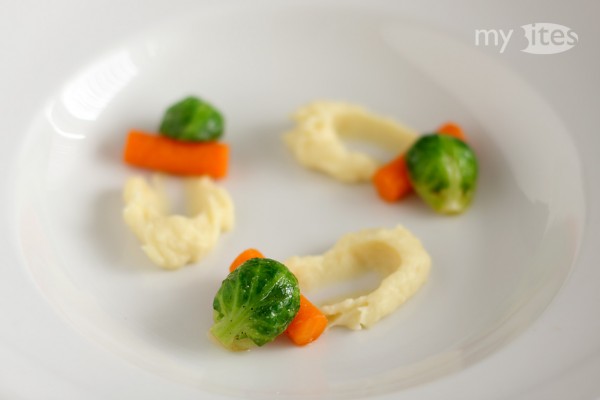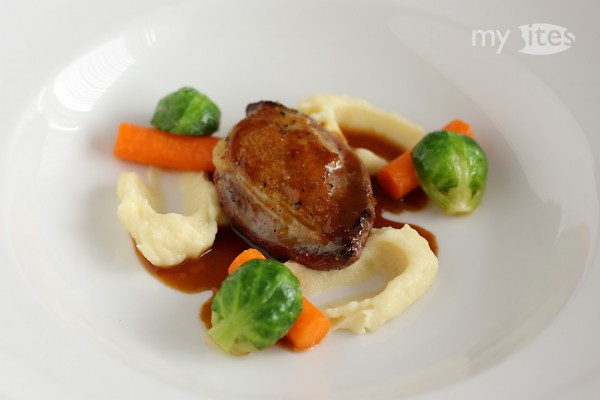I wondered why red or white wine is usually added to reduced sauces. Usually the wine is allowed to cook off completely, so in most cases – as long as you’re not cooking specifically a red wine sauce – wine is not so much added for its taste than rather for its acidic component. Another function of the wine is to scrape off the brown roasted parts from the bottom of the pot, but for this purpose water works perfectly well too. Instead of the wine I had the idea to add some quince as an acidic component. Cooking quince over a long time magically enhances its flavor, so I thought it would work ideally in a sauce too, since the the basic stock had to be cooked for several hours. The quince worked really well in the sauce, so if you have any problems with adding alcohol to a sauce – although the alcohol will cook off completely – during autumn you can add some fresh quince instead.
Because I planned to serve the quince sauce with pigeon breasts and at my local market they serve only whole pigeons, I roasted the legs, wings, back, neck and other bones and used them in the sauce. It gave the sauce a deeper flavor which enhanced the quick roasted pink pigeon breasts.
Because the pigeon breast is not a huge piece of meat, I planned rather small garnishes. Fall vegetables are so bright and colorful. These three, namely parsnip, Brussels sprouts and squash you can get during the whole winter too, so they might just be the right choice if you want to brighten up a dark day. Fall and winter vegetables tend to be more strong and earthy, but they also work better with rich, roasted sauces. This combination of creamy parsnip puree, soft squash and snappy Brussels sprouts was the optimal accompaniment for the quince sauce and pigeon breast.
[amd-zlrecipe-recipe:19]



Never had pigeon so far, but this beautiful dish makes me want to try it asap! The sauce must be amazing, and I bet it goes just perfectly well with the pigeon!
Pigeons and quails are nice if you want to practice your cutting and anatomy skills – and if you don’t plan to eat too much meat. There are about 2 bites of meat on the legs, probably they could be prepared separately, but the other parts work best in a sauce or soup. Last year I prepared a similar dish with pears and coffee roasted beets – remember? 😉 You created quite a lot of beet dishes during last winter, I’m looking forward to your ideas for this winter! 😉
Well, I have already prepared quails, but I confess, I asked my father to debone the breasts, so I indeed need to practice. Oh yeah, that was one more gorgeous dishes of yours! I am quite sure, that this winter it will be just the same. 😉
I came to visit your blog through chrisis link.
What a wonderful idea to take pictures of sampling all components of a dish on the plate!
I like your style.
You asked your father, Noémi? Now I’m disappointed 😉 Deboning and cutting an animal into its parts really helps to get more in contact with the original source of our meat and to respect all parts of an animal. I’m looking forward to your colorful and creative winter dishes too 😉
Thank you, Eline! I really appreciate your comment. I don’t like taking photos while cooking because it simply destroys the whole creative process. Although sometimes I take pictures of the mess I just created 😉 While at plating I already have an image in mind, so taking photos of steps building a plate is not so interrupting. Of course, the plates are always warmed or chilled, depending on what I’m going to put on it. I hope it also helps my readers to demystify beautiful plate constructions by seeing the steps.